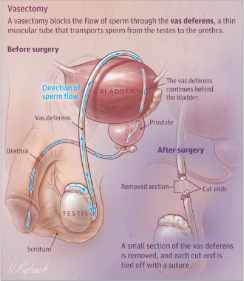By : Geraldus Sigap
Many men remain hesitant about undergoing a vasectomy due to concerns about pain, high risk, or negative effects on sexual performance. In fact, vasectomy is one of the safest and most effective long-term contraceptive methods, offering a quick procedure and minimal recovery.
What Is a Vasectomy?
Vasectomy is a medical procedure that prevents pregnancy by cutting or sealing the sperm ducts (vas deferens) so that sperm does not mix with semen during ejaculation. It is considered a permanent contraceptive method for men and is performed under local anesthesia without requiring hospitalization.
After a vasectomy, the testicles continue to produce testosterone and sperm. However, sperm is naturally reabsorbed by the body, as it no longer exits through ejaculation.

Figure 1. Vasectomy Procedure
How Is a Vasectomy Performed?
Vasectomy is a minor procedure that typically takes less than 30 minutes. There are two main methods:
- Conventional Vasectomy
A small incision is made in the scrotum to access and cut the vas deferens, which are then tied or cauterized.
- No-Scalpel Vasectomy
A special tool is used to make a tiny puncture instead of an incision. This technique causes less pain, bleeding, and infection risk, and offers faster recovery.
Both methods are performed under local anesthesia, and most patients can return to light activity within 1–2 days.
Benefits of Vasectomy as Male Contraception
Vasectomy has an effectiveness rate of over 99%. Additional benefits include:
- No impact on hormones, libido, or sexual function
- Safer than long-term hormonal birth control for women
- Quick procedure, no hospital stay required
- Minimal side effects and complications
- Long-term solution for couples who do not want more children
Vasectomy Myths and Facts
Many myths surrounding vasectomy discourage men from considering the procedure. Here are some facts:
- Myth: Vasectomy causes impotence
Fact: Vasectomy does not affect erection, libido, or orgasm.
- Myth: Sperm “builds up” inside the body
Fact: Sperm continues to be produced but is naturally reabsorbed by the body.
- Myth: Vasectomy is immediately effective
Fact: It takes a few weeks or ejaculations for sperm to completely clear from semen. A semen analysis is required to confirm.
Can a Vasectomy Be Reversed?
Technically, yes. Vasectomy can be reversed through a procedure called vasovasostomy, but the success rate decreases over time and is not guaranteed. Therefore, vasectomy should only be chosen if you and your partner are certain about not wanting more children.
Side Effects and Recovery
After the procedure, some men may experience mild swelling, pain, or bruising in the scrotum. These symptoms are usually temporary and resolve within a few days. Doctors typically recommend:
- Applying ice packs during the first 24 hours
- Wearing supportive underwear
- Avoiding strenuous activity for a few days
- Refraining from sexual activity until cleared by a doctor
Who Is a Good Candidate for Vasectomy?
Vasectomy is ideal for men who:
- Have completed their family
- Do not wish to have more children in the future
- Want to help their partner stop using hormonal contraception
- Seek a long-term, low-risk birth control option
Post vasectomy care
After undergoing a vasectomy, patients are advised to follow post-procedure care instructions to promote faster recovery and avoid complications. Here are the key points to keep in mind:
- Rest and Recovery
Total rest is highly recommended for the first 24–48 hours. Avoid strenuous activities, heavy lifting, or intense exercise for at least 3–7 days. Applying ice packs to the scrotum can help reduce swelling.
- Pain Management
Patients may take pain relievers such as ibuprofen as recommended by their doctor. Supportive underwear (such as briefs or athletic supporters) can help reduce discomfort.
- Wound Care
The incision area should be kept clean and dry for at least 48 hours. Avoid soaking in baths, swimming, or taking hot showers until the wound has fully healed. Showering is allowed after 24 hours.
- Sexual Activity and Protection
Sexual intercourse should be avoided for at least 7 days after the procedure. Even after the vasectomy, patients must continue using condoms or other contraceptive methods until a sperm analysis confirms that no sperm remain.
- Post-Vasectomy Sperm Analysis
To confirm that the procedure was successful, patients must undergo a semen test 2–3 months after the procedure or after about 15–20 ejaculations. If two consecutive tests show no sperm, the patient is considered medically sterile.
When Should You Consult a Doctor?
If you are considering vasectomy as a contraceptive method, consult a urology specialist first. The doctor will explain the benefits, risks, and help ensure that you fully understand the implications of the procedure. The medical team at RS Abdi Waluyo is ready to provide professional, safe vasectomy services. Call 021-3144989 or book an appointment online for further discussion.
FAQ
What is a vasectomy?
Vasectomy is a permanent male contraceptive procedure that involves cutting or sealing the sperm ducts (vas deferens), so sperm does not exit during ejaculation.
Does vasectomy affect sexual performance?
No. Vasectomy does not affect erections, sexual desire, or orgasm. Men can continue sexual activity as usual.
Is vasectomy immediately effective?
No. It takes several weeks or ejaculations to clear all remaining sperm from semen. A semen analysis is needed to confirm sterility.
What’s the difference between conventional and no-scalpel vasectomy?
Conventional vasectomy involves a small incision, while no-scalpel uses a puncture without a blade. No-scalpel is less painful and has quicker recovery.
Can vasectomy be reversed?
Technically yes, through surgery (vasovasostomy), but it’s not always successful. Vasectomy should be chosen when you are certain about not having more children.
What are the side effects after vasectomy?
Mild swelling, pain, or bruising in the scrotum may occur temporarily and typically go away within a few days.
Resource :
- Fainberg J, Kashanian JA. Vasectomy. JAMA 2018;319(23):2450.
- Stormont G, Deibert CM. Vasectomy [Homepage on the Internet]. In: StatPearls. Treasure Island (FL): StatPearls Publishing, 2025 [cited 2025 May 26]; Available from: http://www.ncbi.nlm.nih.gov/books/NBK549904/
- Wahyu W, Fanumbi EAF, Sumarta WOV, et al. Concept Analysis of Vasectomy Method Selection Decisions: A Literature Review. Indones J Glob Health Res 2024;6(S6):1003–1014.
